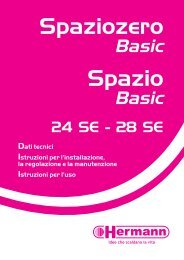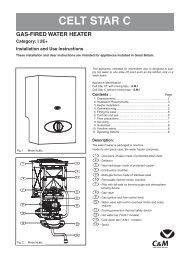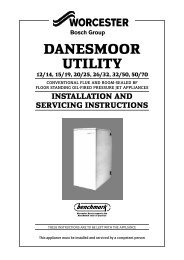sy24inst2 - The Initiative Group
sy24inst2 - The Initiative Group
sy24inst2 - The Initiative Group
Create successful ePaper yourself
Turn your PDF publications into a flip-book with our unique Google optimized e-Paper software.
Rendamax<br />
1.2.1 Description of principal components<br />
<strong>The</strong> boiler is constructed from the following principal components:<br />
Fan [26]<br />
<strong>The</strong> DC fan, which is equipped with a speed feedback, draws in the combustion air and increases<br />
the air pressure. <strong>The</strong> speed feedback signal is relayed to the regulator, which adjusts the speed if<br />
need be.<br />
Gas train<br />
<strong>The</strong> principal component of the gas train is the main gas valve [25]. <strong>The</strong> quantity of gas is adjusted<br />
in proportion to the quantity of air being supplied. <strong>The</strong> quantity of air depends on the speed of<br />
the fan. As an option, the unit can be equipped with a gas filter [27].<br />
Burner [4]<br />
After the gas/air mixture has been distributed over the burner using a distribution plate, the mixture<br />
is burnt on the burner surface such that the flame is directed downward. <strong>The</strong> burner is both<br />
air and water-cooled. <strong>The</strong> water headers are constructed of cast iron, and ensure a two-pass flow<br />
through the burner.<br />
Heat exchangers [6, 7 and 8]<br />
<strong>The</strong> first heat exchanger is constructed of smooth stainless steel pipes and transfers most of the<br />
combustion energy to the system water. <strong>The</strong> second heat exchanger is constructed of laser-welded,<br />
stainless steel finned pipes. <strong>The</strong> third heat exchanger is constructed of smooth stainless steel<br />
pipes. <strong>The</strong> second and third heat exchanger transfer the heat from the combustion gasses to the<br />
system water. All water headers are made of cast iron, and ensure a five-pass or three-pass flow<br />
through the heat exchangers (depending on the type). <strong>The</strong> space between the burner and the first<br />
heat exchanger constitute the combustion chamber.<br />
Water headers [21]<br />
<strong>The</strong> water headers are part of the burner and the heat exchangers.<br />
Water connections<br />
<strong>The</strong>se consist of a flow connection [13] and a return connection [19]. Both of these connections are<br />
provided with a filling/drain valve [18]. <strong>The</strong> flow switch [20] is fitted on the flow line.<br />
Boiler Pump [28]<br />
<strong>The</strong> pump installed in the bypass supplies the required head and capacity for the burner, 1 st heat<br />
exchanger and 2 nd heat exchanger and overcomes the resistance of these three parts.<br />
Condensate receptacle [9]<br />
A condensate receptacle is fitted underneath the last heat exchanger. This receptacle is equipped<br />
with a condensate and flue gas outler.<br />
Frame [17]<br />
<strong>The</strong> frame is constructed from steel profile sections and is fitted with vibration absorbing adjusting<br />
feet [16].<br />
Casing [1]<br />
<strong>The</strong> casing consists of easy-to-remove panels. Once the cover has been opened (using tools), all<br />
other panels can be removed without using tools.<br />
<strong>The</strong> electrical section<br />
This includes the control and safety circuits for the unit.<br />
Connecting terminals<br />
<strong>The</strong> boiler supply, the connecting terminals, the pump connection and the pump relay are all fitted<br />
on top of the boiler. <strong>The</strong> terminal strip is located under the cover, on the right hand side.<br />
Doc586/50CV22C 47









